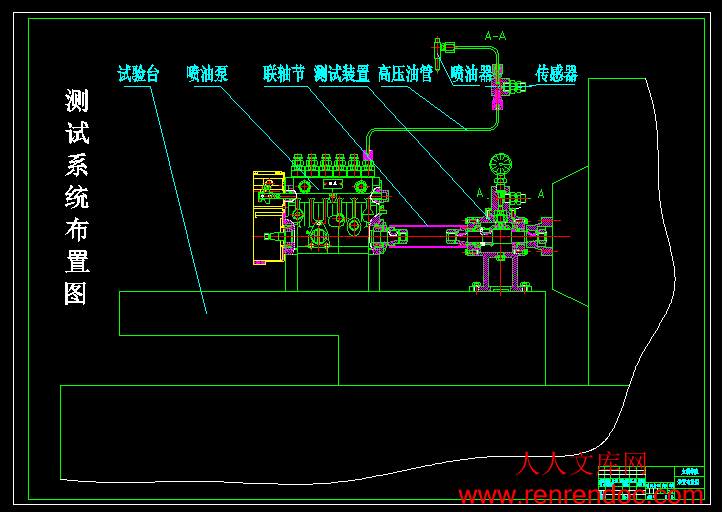汽车发动机油路测量设备的机构设计
39页 26000字数+说明书+任务书+开题报告+5张CAD图纸【详情如下】
任务书.doc
壳体A0.dwg
外文翻译--带式输送机及其牵引系统.doc
柱塞套A2.dwg
汽车发动机油路测量设备的机构设计开题报告.doc
汽车发动机油路测量设备的机构设计论文.doc
相关资料.doc
端盖部件A4.dwg
联轴节A1.dwg
装置布置图A0.dwg
计划周记进度检查表.xls
摘 要
柴油机供油系统多参数的电测量,为研究供油系统喷射特性提供了手段。而且,目前在评估新品开发设计的喷油泵和喷油嘴的性能时,在产品改进和新品试制过程中,为了获得良好的性能指标,往往需要对燃油喷射系统进行大量的调试工作,也常以多参数的电测量作为考核项目之一。柴油发动机油路压力测量设备相关油管嘴端压力与针阀体压力室压力喷油泵的参数选择及其对柴油机性能的影响,以及柴油内燃机异常喷射现象和柴油发动机油路压力测量设备相关油管嘴端压力与针阀体压力室压力。
关键词:压力喷油泵的参数选择;内燃机异常喷射现象;相关油管嘴端压力
目 录
摘 要III
AbstractIV
目 录V
1 绪论1
1.1 设计目的1
1.2 柴油发动机的燃料喷射装置概述1
1.3 喷油过程2
1.4 几何供油规律和喷油规律的定义3
1.5 喷油器总成3
2 柴油发动机油路压力测量设备的设计5
2.1 柴油发动机油路压力测量设备控制系统概述5
2.2 柴油发动机油路压力测量设备的原理7
2.3 柴油发动机油路压力测量设备相位调整7
2.4 柴油发动机油路压力测量设备测量线路7
2.5 柴油发动机油路压力测量设备试验结果分析10
2.6 柴油发动机油路压力测量设备校验压电压力传感器11
2.7 柴油发动机油路压力测量设备相关油管嘴端压力与针阀体压力室压力11
3 机械传动选用及设计计算12
3.1 圆锥齿轮的计算12
3.2 主传动轴的相关概算13
3. 3 花键联轴器的计算14
3.4 压力波动的分析15
3.5 燃油的可压缩性15
3.6 管路的容积变化16
3.7 管路中的压力波动16
3.8 喷油泵的参数选择及其对柴油机性能的影响17
3.9 喷油泵的速度特性校正19
3.10 可变减压容积19
3.11 可变的减压作用19
3.12 高压油管20
3.13 柴油内燃机异常喷射现象20
3.14 二次喷射21
3.15 稳定喷射22
4 测试精度23
总结26
致 谢28
参考文献29
1 绪论
1.1 设计目的
柴油机供油系统多参数的电测量,为研究供油系统喷射特性提供了手段。而且,目前在评估新品开发设计的喷油泵和喷油嘴的性能时,也常以多参数的电测量作为考核项目之一。因此,测量的精确性就显得越发重要了。
在以往的电测试验中,出现过油嘴已喷油的工况下,测出的油管压力低于油嘴开启压力的情况。例如在二零零二年八月高速一号泵的电测试验中,油嘴开启压力为12。5MPA,当油泵转速为250RPM时,测出的嘴端最高压力只有11。69MPA。还有,日本VE泵在二零零二年九月的试验中,油嘴开启压力为18。13MPA(185kgf/cm2),在油泵转速为390RPM时,测出的嘴端最高压力只有17。013MPA(173。6 kgf/cm2)。在上述两例试验中,油嘴针阀均已开启喷油。
现有使用的传感器、信号转换仪、数据处理仪、都是具有世界先进水平的仪器。精度很高,随机误差很小。这就要考虑是否存在较大的系统误差,即要从测试方法的角度去考虑了。目前一般采用压电式传感器测量压力。压电传感器因其机械强度高,体积小,重量轻、高频特性良好,输出线性好等优点,而被广泛采用。但当被测压力变化频率低,变化幅度小时,压电晶体的电荷量变化难于反映到测量结果中,即压电传感器的低频特性差。而我们测量的油路中存在这种变化频率低、幅度小的压力——高压油管中的残留压力。因此,压电传感器是测不出这种压力的。上面提到的现象极可能是因为测不出残留压力而产生的。
在课题立项时,还曾考虑过压电传感器灵敏度变化问题,还有高压油管嘴端压力与针阀体内压力室的压力差异问题,是否会对压力测量精度产生一定的影响。这些都将在下面的论文中予以阐述。
1.2 柴油发动机的燃料喷射装置概述
燃油喷射装置是柴油机的一个重要组成部分,在产品改进和新品试制过程中,为了获得良好的性能指标,往往需要对燃油喷射系统进行大量的调试工作,根据大量实践表明,对现代柴油机喷射装置的要求是:
(1) 能精确的控制每循环的喷射量(并要求每缸等量),并在规定的时间内(喷射持续角)喷入汽缸,换言之,即要求具有合适的喷油率。
(2) 为了优化柴油机的性能、烟度、噪声和排放,需要具备能随柴油机负荷和转速变的、精度为±1℃A的喷油提前角。
(3) 为了将柴油和空气混合,需要高的喷射压力,对具有强空气涡流的直喷式或非直喷式柴油机,最大喷射压力为30~40MPA,对低涡流直喷式,最大喷射压力约为45~48MPA,对无涡流直喷式,最大喷射压力在100MPA以上。
近年来,得到蓬勃发展的电控喷射系统,在实现要求(2)方面已比常规的机械液力式喷射装置显示出更大的优越性,并开辟了将喷油系统控制和运输车辆控制结合起来的可能性。1.4 几何供油规律和喷油规律的定义
几何供油规律是指从几何关系上求出的油泵凸轮每转一度(或每妙)喷油泵供入高压系统的燃油量(mm3/(°)泵轴或mm3/s)随凸轮轴转角ψ(或时间t)的变化关系。由于它纯粹是几何关系决定的,因此只要知道柱塞的运动特性即可。
喷油规律是指在喷油过程中,每秒或每度泵轴转角从喷油器喷出的燃油量随时间或泵轴转角的变化关系。
1.5 喷油器总成
喷油器总成对于柴油机来说,有着非常重要的作用。喷油器总成在发动机上的安装及喷油器总成的喷射性能直接影响柴油发动机的动力性、经济性、使用性能及可靠性。喷油器不仅决定着喷雾质量、油束与燃烧室的配合,而且影响喷油特性(喷油时刻、喷油延续时间、喷油规律),这些都直接影响发动机的性能指标。如果喷油不良,油束和燃烧室配合不好,则混合气形成恶化,燃烧变坏,性能下降。在新产品的试制过程中,往往需要对喷油器作大量的调试,才能使柴油机达到设计指标;在使用过程中,常由于喷油器的故障使发动机性能下降,甚至不能运转。所以喷油器是影响柴油机设计指标和使用性能的关键部件之一。
喷油器总成通过法兰、压板和螺套紧固在发动机的气缸头上,它的喷油嘴端深入到发动机气缸的燃烧室内。喷油器的高压油道通过高压油管与喷油泵总成的出油阀接头相连接,回油油路相互连接直接回到油箱。

 川公网安备: 51019002004831号
川公网安备: 51019002004831号